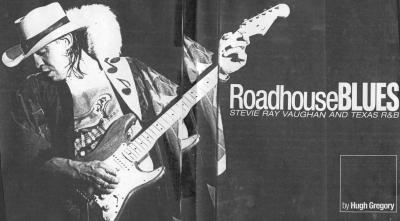Texas R & B
REVIEW by
Willard Manus
"Stevie
Ray Vaughan's influence was such that he needs to be placed within the
context of a broader picture--which means not only other electric guitarists,
but the music of Texas itself, and its neighboring states. Tracing his
history, his inspiration and his legacy, helps explain the secret of why
the blues has survived and thrived through changing fashions, seemingly
against all odds. Taking a basically simple, traditional musical form,
which he loved and cherished, Stevie Ray Vaughan inspired others to explore
and interpret, and to have faith in their own intuition--promoting the
idea that when it comes to the blues, anything goes."

This is how Hugh Gregory introduces ROADHOUSE BLUES: STEVIE RAY VAUGHAN
AND TEXAS R&B (Backbeat Books). The author, a wellknown writer on
pop music, paints a memorable portrait of the late singer/musician, who
blazed so brightly in the 1980s r&b firmament. Vaughan was a musical
hurricane, someone who played and sang with unsurpassed fury and heat,
turning the blues inside out with his unique sound and delivery. His hero
was Jimi Hendrix, who was always "in his heart and fingers."
But Vaughan did not see himself as a Hendrix disciple. "I'm not really
trying to sound like him," he said. "But I'm not going to avoid
what I understand about how he played...It was one of the first times
in a long time when rock music was playued with soul."
Gregory's book is only partially a Vaughan biography; it is more a history of the Texas music and milieu that helped shape Vaughan as an artist. Vaughan, after all, was preceeded by such virtuoso Texas guitarists as Eddie Durham, Charlie Christian, T-Bone Walker and Freddie King, to name but a few. Vaughan grew up on their music, as well as the music played in local roadhouses and honkytonks by lesser known but equally gifted bluesmen. His favorite player was his very own brother, Jimmy. "Ever since I can remember he was, if not the hottest guitar player in Texas, then about to be known as the hottest. Having a big brother like that gives you a lot of incentive, to put it lightly. He knows a lot more than people realize, and he plays about a tenth of what he knows, because he doesn't have to prove what he knows. I end up trying to play everything I can think of."
Although they had worked together on record dates--including Bob Dylan's albnm Under the Red Sky, the two brothers did not cut an album of their own until Jimmy left The Fabulous Thunderbirds, allowing him to team up with his kid brother on Family Style.
Gregory spends considerable time on the making of Family Style, which was produced by Nile Rodgers and featured such players as Al Berry, Larry Aberman, Doyle Bramhall and Preston Hubbard. Rodgers wanted both brothers to sing. That wasn't a problem for Stevie, but his brother had never sung much and had to be pressured into taking the chance.
The result was a memorable record which led to a national tour and big sales. The Vaughan brothers began to make plans for other family albums. Both of them were not only becoming famous but were in the best shape of their lives, having brought their addictive personalities under control and stayed clean for some time.
Tragically, just when Stevie in particular was beginning to win awards and earn worldwide kudos, the helicopter that was taking him (and members of Eric Clapton's band) from an Aug. 1990 concert in Wisconsin to the airport in Chicago, crashed into a fog-bound mountain soon after take off. "Naturally there was speculation among the media that this was another spectacular 'rock 'n roll' death involving drugs and alcohol," Gregory writes. "They were wrong. Stevie Ray had not fallen off the wagon."
Stevie Ray's young life was snuffed out, but his legacy remains and, as one critic remarked, we are "left to wonder how much more this guitar genius might have accomplished."